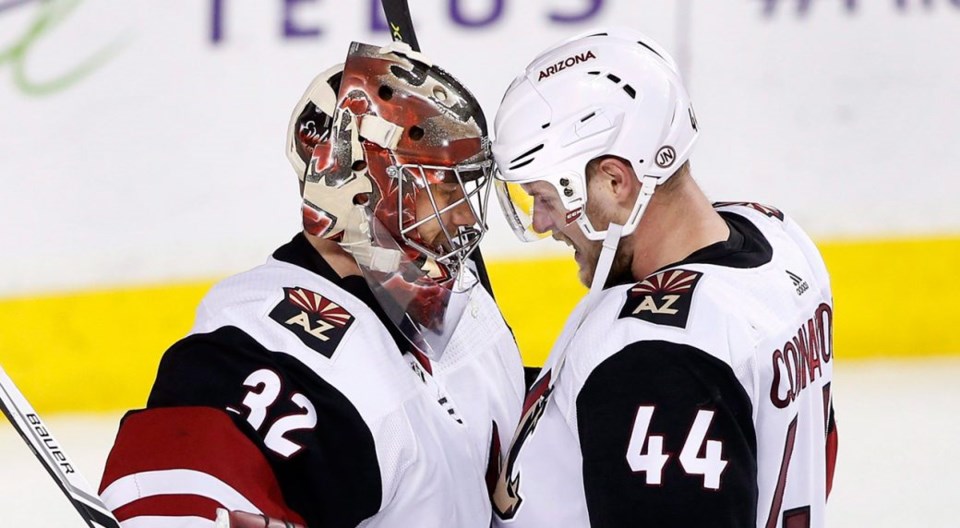The Canucks are going to see a lot of their Pacific Division opponents this season, with 29 of their 82 games coming against their Pacific rivals. How do the Canucks stack up against the other seven teams in their division?
Honestly, not particularly well. That’s why this series of previews is labeled the Pacific Division Preview of Pain.
Next up, however, is a team that’s likely going to be at the bottom of the division standings with them: the Arizona Coyotes. How do the Canucks compare against a team with similarly long odds to make the playoffs?
ARIZONA COYOTES
OFFENCE The Coyotes were one of the few teams to score fewer goals than the Canucks last season, but they did make some changes that should give them a boost.
Trading Max Domi to Montreal for Alex Galchenyuk gives the Coyotes a boost up the middle. Along with Derek Stepan, that’s a decent one-two punch at centre. Clayton Keller led the Coyotes in scoring in his rookie season and could be a point-per-game player if he can avoid the sophomore slump.
The addition of Michael Grabner gives the Coyotes another goal-scoring threat on the wing and the newly-acquired Vinnie Hinostroza is a wild card: the 5’9” forward has produced whenever he’s been given a chance. The Coyotes also get production from their blue line. Oliver Ekman-Larsson is a consistent 40-point defenceman, while Alex Goligoski chipped in 12 goals and 35 points last season.
For both the Canucks and Coyotes, goal-scoring is likely to be a challenge next season. For now, we’ll call this even.
Advantage: Neither
DEFENCE Getting a long-term extension signed with Oliver Ekman-Larsson was a big win for Coyotes GM John Chayka. Ekman-Larsson is a legitimate number one defenceman that plays significant minutes in every situation and forms a solid top pairing with Jason Demers.
Alex Goligoski and Niklas Hjalmarsson are a decent second pairing, even if they haven’t quite lived up to expectations. Kevin Connauton provides a little offence in a sheltered third-pairing role, while Jordan Oesterle could surprise after a quietly effective season with Chicago last season.
What could provide a boost on defence is a breakout season from 20-year-old Jakob Chychrun in his third year in the NHL. Injuries have hindered him a little, but he still has some serious potential and could really solidify their defence corps.
Advantage: Coyotes
GOALTENDING The Coyotes’ season largely depends on the health and play of Antti Raanta. The Coyotes were the worst team in the NHL over the first half of their season, while Raanta missed time with various injuries. In the back half of the season, they went on a tear, largely due to the performance of Raanta. They had 54 points over their final 41 games, a 108-point pace.
Raanta finished the season with an outstanding .930 save percentage and is a sleeper pick for the Vezina trophy this coming season. He’ll have to be for the Coyotes to overcome their goal-scoring troubles.
Backing up Raanta will be Darcy Kuemper, who has a career .912 save percentage and should provide some stability to the backup goaltender position after a carousel of mediocrity last season.
Advantage: Coyotes
SPECIAL TEAMS The Coyotes’ power play was outright terrible last season, finishing 26th in the NHL. Their penalty kill was only a little better, finishing 19th.
Two of their additions could help: Galchenyuk had 24 points on the Montreal Canadiens’ power play, while Grabner is a very good penalty killer whose speed makes him a threat to score short-handed. A healthy Raanta should also boost the penalty kill.
The Canucks should still have a better power play, however, and they made their own additions to the penalty kill. Let’s give the nod to the Canucks on this one.
Advantage: Canucks
OVERALL It feels like every season is supposed to be the season the Coyotes turn it all around. They have numerous young players and prospects that seemed poised to break out at any time, a legitimate number one defenceman, and they seem to finally have found the answer in net.
And yet, it’s hard to believe in them. There are just too many question marks. Will the young players be able to carry the load? Can Galchenyuk effectively transition to centre after years on the wing in Montreal? Will Dylan Strome break through? Can Raanta handle 60+ starts?
Statistical models peg the Coyotes to finish with anywhere between 76 and 90 points https://theathletic.com/509092/2018/09/08/2018-19-nhl-season-preview-arizona-coyotes/, which would put them outside the playoffs, but also ahead of the Canucks. Those point projections are incredibly far apart, which makes sense given how wildly different the first and second halves of last season were for the Coyotes.
If the Coyotes can capture the magic of their latter-half run last season, they could be in the mix for a playoff spot. It’s hard to make a similar argument for the Canucks.
Advantage: Coyotes



